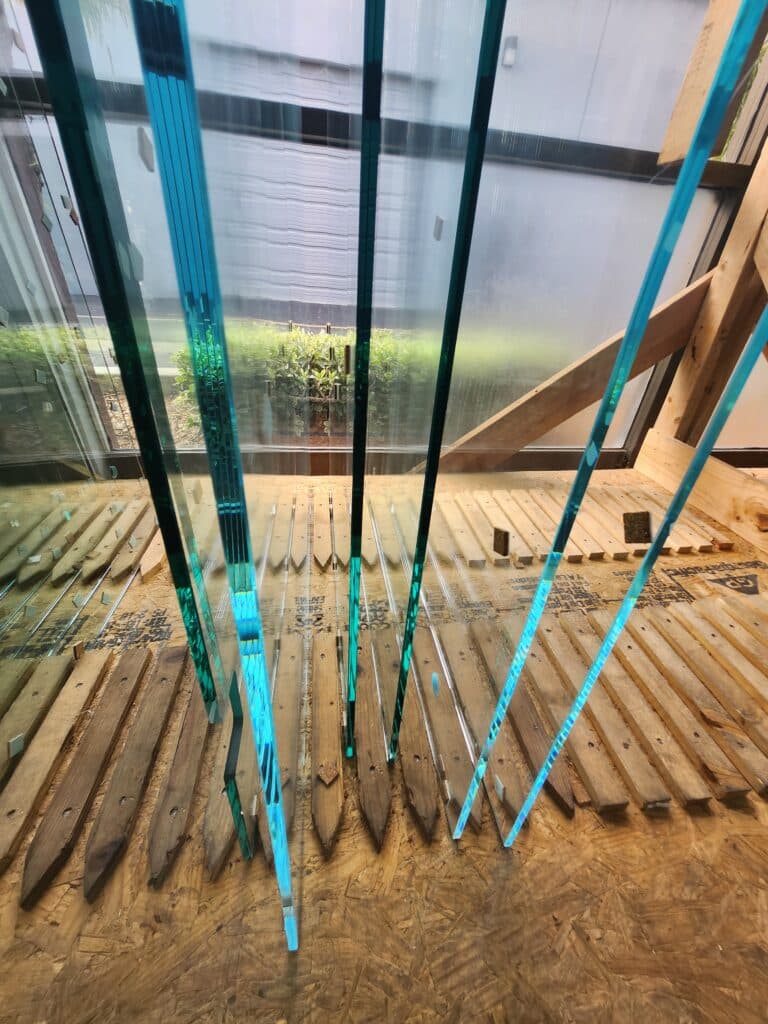Wait. There’s more than one type of clear glass?? Yes! And we’re here to ‘clear’ up any confusion. If you’re like most people we meet with, you will experience one of three reactions after reading this article.
- Sure, there’s a slight difference but not enough to justify the cost
- I wish you hadn’t told me about this! I never noticed the green before!
- Of course I want clear. Green is not clear.
Before we start with the differences, it’s important to acknowledge 2 key similarities:
- Both types of glass are safety tempered. One is not more durable than the other
- Both types are well-suited as frameless glass. One is not ‘better’ than the other

Regular/Standard Clear Glass
By far the most common type of glass, clear glass can be found nearly everywhere you look. Car windows, house windows, glass shelves, coffee tables, dining tables, China cabinets are all primarily made with clear glass. You can even test this with glass found in your home or office right now; look at the glass shelves in your shower niche, medicine cabinet, or the glass on your coffee table or desk. See the green on the edge? That’s a result of the iron oxide present in the clear glass formula; the light hits the iron and our eyes perceive it as green. This ‘green’ is more apparent on the edge and becomes more pronounced with thicker and larger pieces of glass. As you look through the glass, the green is more easily noticed when next to a white or lighter colored surface; which brings us to shower doors.
Many new shower remodels incorporate white subway tiles, white marbled porcelain, marble, and quartz- all lighter colors that make it easier to notice the ‘green’ of the standard clear shower glass. Again, this is not a ‘bad’ thing. Since frameless shower doors are built to last, it’s important for you to know as much as possible before making such a long-lasting decision.
Low Iron Glass/Starphire/Optiwhite
Growing in popularity in recent years, low iron glass is a premium alternative to clear glass. The formula for this type of material has much lower iron content, and therefore no apparent ‘green tint’. The little iron that is present causes a kind of aqua blue hue on the edge of the glass. When looking through this type of glass, lighter toned surfaces such as white tile will maintain that bright white aesthetic. The process to reduce the iron, and the material used to make this type of glass substantially increase the material cost of your shower door compared to standard clear glass; the difference can be as much as 30-45% more.

Which One is Best for Your Shower?
Now that you’ve decided that privacy glass isn’t needed for your shower and clear glass is the way to go, which clear option should you go with? The answer all comes down to a matter of opinion; and as the investor in your shower, the only opinion that really matters is yours. To help you with this we’ve collected images of a variety of showers, some where the homeowner chose standard clear and others that went with low iron glass.
Now, you might be the type of person that needs to see the 2 options in person. We have both types of glass on display at our location in Laguna Niguel. Call us today to make an appointment.
If you would like to see the differences in your bathroom, call us today to schedule a visit from one of our Measure Technicians; they will bring samples of both the regular and low iron glass so you can be better equipped to make the best decision for your shower door.
Summary
You have 2 excellent options to choose from to complete the look of your bathroom with a new frameless shower door: the most commonly used clear glass or the premium low iron glass. Standard clear is included in the base price for most quotes you will receive, and low iron glass will mean a substantial increase in cost. Both are high-quality, safety tempered, and extremely durable.
The decision you make will come down to your shower tile, your eye, and your budget. Get started on making your decision by finding out how much each option will cost for your new shower door. Call us today for a free quote.
Further Reading
For those interested in exploring more about the differences between clear glass and low iron glass, as well as their applications and benefits, check out the following resources:
- The Difference Between Clear & Low-Iron Glass – An insightful look at how clear glass, while common, is not as transparent as its low-iron counterpart due to the iron content that gives it a greenish tint. This resource further explores suitable applications for low-iron glass and tips for choosing the right type for your project. Read more at Dillmeier Glass.
- Low Iron Glass VS Clear Glass – Which one is better? – A comprehensive comparison that highlights the main differences, benefits, and applications of low iron glass versus clear glass. It also discusses the transparency and color tint of both types of glass. Explore at Fab Glass and Mirror.
- Low Iron Glass vs. Standard Clear Glass – An article detailing the visual and functional differences between low-iron and standard clear glass, particularly in the context of shower doors. It offers a side-by-side comparison to help visualize the clarity difference. Learn more at Basco Shower Doors.
- Low Iron Glass VS Clear Glass, Which One Is A Better Option? – This piece delves into the technical differences between low-iron and clear glass, including color, transparency, and the tempering process. It also covers the price difference and benefits of each type. Discover more at Shenzhen Dragon Glass.
- What’s the difference between Clear Glass and Low Iron Glass? – A resource that explains the iron content difference between clear and low iron glass and how it affects the glass’s appearance and applications. It is particularly useful for architectural projects where color and clarity are important. Check it out at Goldray Glass.
These resources will help you understand the nuances between clear and low iron glass, ensuring you make the best choice for your needs.
Author Profile:
I pride myself on my meticulous attention to detail, a quality that has been sharpened through measuring and designing over 9,000 shower doors since 2017. My background in drafting has equipped me with the principles I apply to every field drawing, ensuring each measurement is both precise and accurate.


